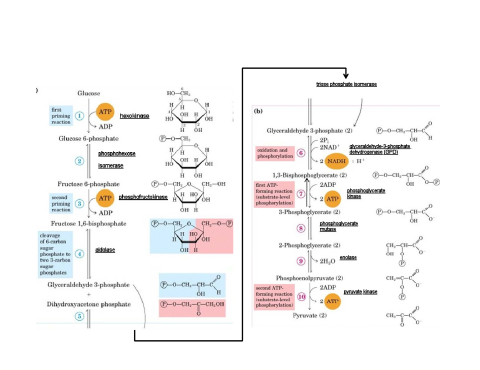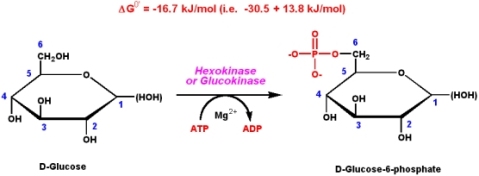First, a jingle. How about a Glucose song??
Glycolysis is the pathway where a glucose sugar is split into 2 pyruvate sugars. This pathway is said to be the ancestor of all metabolic pathways where it occurs in the cytosol of humans, plants, bacteria or even yeast cells. The many function of Glyolysis is to generate ATP (energy) and NADPH. It is composed of 2 major stages;
- Energy Investment Phase (Preparator Phase)
- Energy Generation Phase (Payoff Phase)
Biological catalysts are used in the 10 steps. These enzymes as you all know speeds up the reaction. They are made up of proteins where in extreme heat will become denatured where their 3D shape will unravel hindering the pathway.
The 10 steps of Glycolysis is layed out in the picture below, the enzymes used at each step is in bold black.
In the first stage of Glycolysis there are two irreversible steps they are;
- Step1 where glucose is converted to Glucose-6- Phosphate with the help of Hexokinase. This is a Phosphorylation reaction where a Phosphate group is added to Glucose.
This reaction is done so that Glucose can be trapped in the cell also making it reactive which would promote this reaction.
Mg2+ is the Co-factor used in this reaction, now a co-factor is a non-protein molecule which forms a complex with some enzymes and is necessary for their activity. It may be a metal ion or a co-enzyme.
- Step 3 where Fructose-6- Phosphate is converted to Fructose-1,6-Bisphosphate with the help of Phosphofuctokinase 1.
Phosphofructokinase 1 is the most regulated enzyme in this Pathway. Why is the product called (Bis) and not Di? Easy, this is a Phosphorylation reaction meaning that a Phosphate group is added to a Carbon, but wait! it is already has a Phosphate group attached to its structure (view image below), this new Phosphate is not attached to the same Carbon as his padner before. Thats why its Bis and not Diphosphate.
In Stage 2 of Glycolysis there is only 1 irreversible step, this is step 10. Here Phosphoenolpyruvate (PEP) is converted to Pyruvate!!!!!!!!!!!! with the help of the enzyme Pyruvate Kinase. Now this reaction is the most energetically favourable reaction in the entire Glycolysis Pathway because the molecule PEP is extremely energetic. For every 1 PEP molecule 1 ATP molecule is produced and there are 2 PEP molecules so 2 ATP molecules are produced at this step.
Glycolysis is a very important Pathway without it we wouldnt be able to do basic activities like get up!!!!!!!







0 comments:
Post a Comment